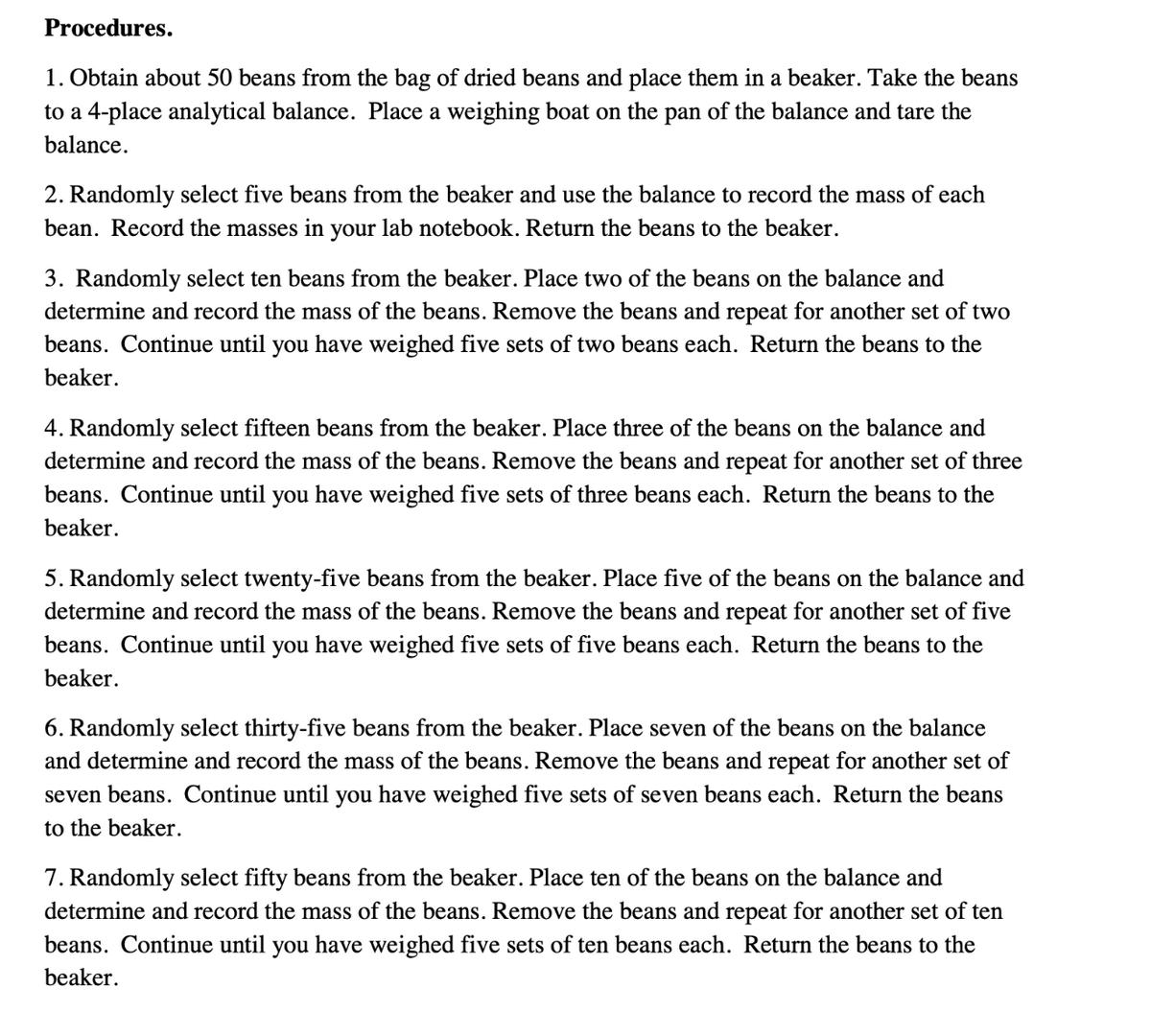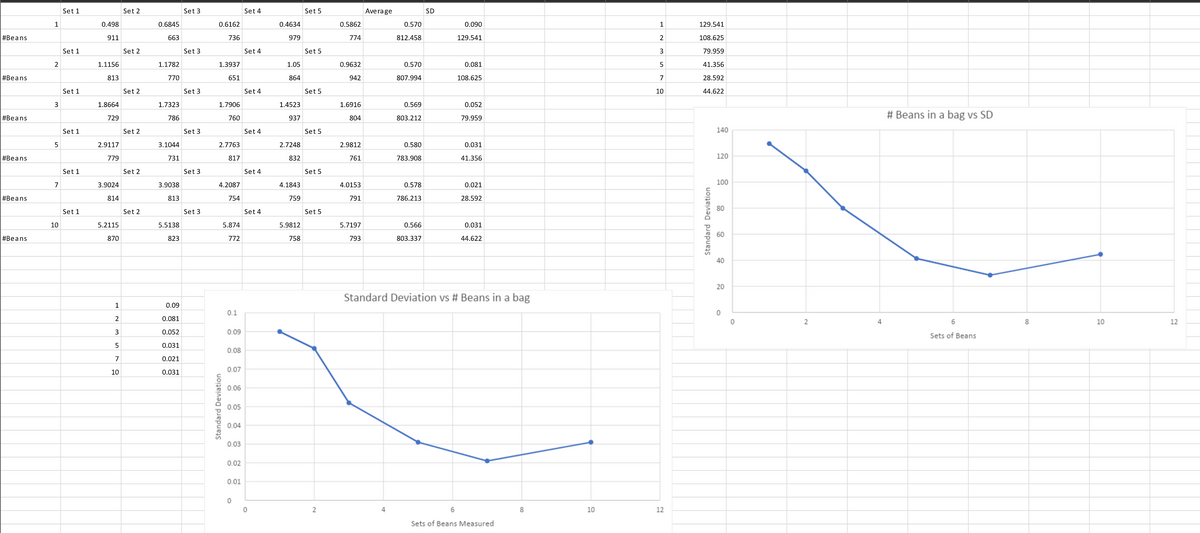What happens to the range of values you obtain as the number of beans in the sample increases? If you took samples of 15 beans per set would your results be much more precise than those obtained from the 10-bean sets? Why or why not? You have been assigned to determine the amount of aflatoxin (a toxin produced by fungus) in the peanuts in a 100 lb. sack. Why would it be a bad idea to measure the amount of aflatoxin in the first two peanuts you pull from the sack? What would be a better approach to making your determination?
What happens to the range of values you obtain as the number of beans in the sample increases? If you took samples of 15 beans per set would your results be much more precise than those obtained from the 10-bean sets? Why or why not? You have been assigned to determine the amount of aflatoxin (a toxin produced by fungus) in the peanuts in a 100 lb. sack. Why would it be a bad idea to measure the amount of aflatoxin in the first two peanuts you pull from the sack? What would be a better approach to making your determination?
Algebra & Trigonometry with Analytic Geometry
13th Edition
ISBN:9781133382119
Author:Swokowski
Publisher:Swokowski
Chapter10: Sequences, Series, And Probability
Section10.8: Probability
Problem 30E
Related questions
Question
What happens to the
If you took samples of 15 beans per set would your results be much more precise than those
obtained from the 10-bean sets? Why or why not?
You have been assigned to determine the amount of aflatoxin (a toxin produced by fungus) in the
peanuts in a 100 lb. sack. Why would it be a bad idea to measure the amount of aflatoxin in the
first two peanuts you pull from the sack? What would be a better approach to making your
determination?

Transcribed Image Text:Procedures.
1. Obtain about 50 beans from the bag of dried beans and place them in a beaker. Take the beans
to a 4-place analytical balance. Place a weighing boat on the pan of the balance and tare the
balance.
2. Randomly select five beans from the beaker and use the balance to record the mass of each
bean. Record the masses in your lab notebook. Return the beans to the beaker.
3. Randomly select ten beans from the beaker. Place two of the beans on the balance and
determine and record the mass of the beans. Remove the beans and repeat for another set of two
beans. Continue until you have weighed five sets of two beans each. Return the beans to the
beaker.
4. Randomly select fifteen beans from the beaker. Place three of the beans on the balance and
determine and record the mass of the beans. Remove the beans and repeat for another set of three
beans. Continue until you have weighed five sets of three beans each. Return the beans to the
beaker.
5. Randomly select twenty-five beans from the beaker. Place five of the beans on the balance and
determine and record the mass of the beans. Remove the beans and repeat for another set of five
beans. Continue until you have weighed five sets of five beans each. Return the beans to the
beaker.
6. Randomly select thirty-five beans from the beaker. Place seven of the beans on the balance
and determine and record the mass of the beans. Remove the beans and
for another set of
seven beans. Continue until you have weighed five sets of seven beans each. Return the beans
to the beaker.
7. Randomly select fifty beans from the beaker. Place ten of the beans on the balance and
determine and record the mass of the beans. Remove the beans and repeat for another set of ten
beans. Continue until you have weighed five sets of ten beans each. Return the beans to the
beaker.

Transcribed Image Text:#Beans
#Beans
#Beans
#Beans
#Beans
#Beans
1
2
3
5
7
10
Set 1
Set 1
Set 1
Set 1
Set 1
Set 1
0.498
911
1.1156
813
1.8664
729
2.9117
779
3.9024
814
5.2115
870
1
SIWN
5
7
10
Set 2
Set 2
Set 2
Set 2
Set 2
Set 2
0.6845
663
1.1782
770
1.7323
786
3.1044
731
3.9038
813
5.5138
823
0.09
0.081
0.052
0.031
0.021
0.031
Set 3
Set 3
Set 3
Set 3
Set 3
Set 3
0.6162
736
1.3937
651
1.7906
760
2.7763
817
4.2087
754
Standard Deviation
5.874
772
0.1
0.09
0.08
0.07
0.06
0.05
0.04
0.03
0.02
0.01
0
Set 4
Set 4
Set 4
Set 4
Set 4
Set 4
0
0.4634
979
1.05
864
1.4523
937
2.7248
832
4.1843
759
5.9812
758
Set 5
Set 5
Set 5
Set 5
Set 5
Set 5
2
0.5862
774
0.9632
942
1.6916
804
2.9812
761
4.0153
791
5.7197
793
Average
0.570
812.458
4
0.570
807.994
0.569
803.212
0.580
783.908
0.578
786.213
0.566
803.337
SD
0.090
129.541
0.081
108.625
0.052
79.959
0.031
41.356
0.021
28.592
0.031
44.622
Standard Deviation vs # Beans in a bag
6
Sets of Beans Measured
8
10
123
5
7
10
12
129.541
108.625
79.959
41.356
28.592
44.622
Standard Deviation
140
120
100
80
40
20
0
0
2
4
# Beans in a bag vs SD
6
Sets of Beans
8
10
12
Expert Solution
This question has been solved!
Explore an expertly crafted, step-by-step solution for a thorough understanding of key concepts.
This is a popular solution!
Trending now
This is a popular solution!
Step by step
Solved in 2 steps

Knowledge Booster
Learn more about
Need a deep-dive on the concept behind this application? Look no further. Learn more about this topic, statistics and related others by exploring similar questions and additional content below.Recommended textbooks for you

Algebra & Trigonometry with Analytic Geometry
Algebra
ISBN:
9781133382119
Author:
Swokowski
Publisher:
Cengage

Glencoe Algebra 1, Student Edition, 9780079039897…
Algebra
ISBN:
9780079039897
Author:
Carter
Publisher:
McGraw Hill

Algebra & Trigonometry with Analytic Geometry
Algebra
ISBN:
9781133382119
Author:
Swokowski
Publisher:
Cengage

Glencoe Algebra 1, Student Edition, 9780079039897…
Algebra
ISBN:
9780079039897
Author:
Carter
Publisher:
McGraw Hill